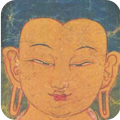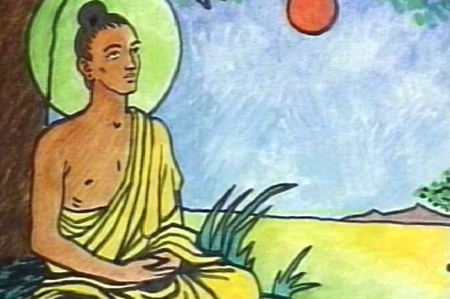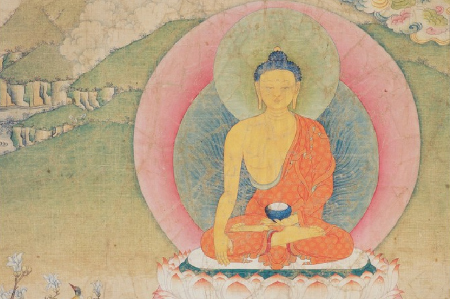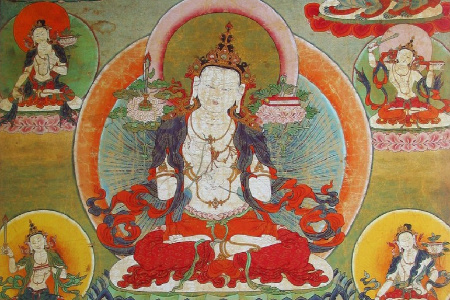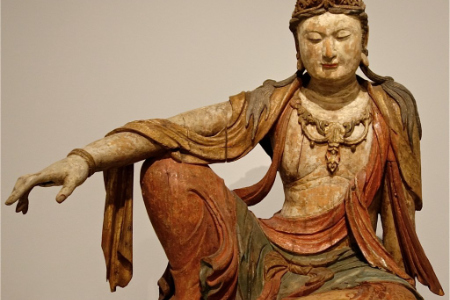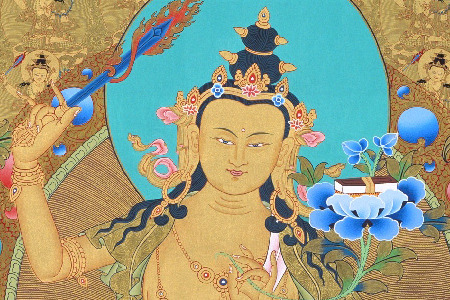INFO about BUDDHISM - aged 12 to 14

The Three Jewels
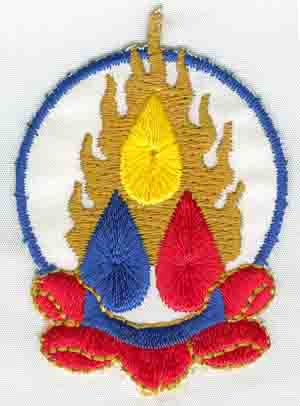 Here is a symbol for theThree Jewels.
Here is a symbol for theThree Jewels.
The top jewel stands for the Buddha. When shown in colour, it is yellow, like the Buddha’s robe.
The left-hand jewel is blue, representing the vast, ocean-like freedom of the Dharma, the Buddha’s teachings.
The right-hand jewel is red and stands for the Sangha, the community of Buddhists.
At his Enlightenment, the Buddha understood How Things Really Are. He also realised that anyone could reach this same understanding and become Enlightened, if they made the effort to understand and to change for the better.
The Dharma describes How Things Really Are, and the method by which anyone can gradually change themselves and come to understand it.
The Sangha is a fellowship of people learning to understand How Things Really Are, by following the Buddha’s teachings and encouraging each other to change.
Noble Eightfold Path

- Right vision, or understanding: understanding that life always involves change and suffering; realising that following the Noble Eightfold Path is the way to overcome suffering and be really happy.
- Right emotion: commiting oneself to wholeheartedly following the path.
- Right speech: speaking in a positive and helpful way; speaking the truth.
- Right action: living an ethical life acording to the precepts.
- Right livelihood: doing work that doesn’t harm others and is helpful to them.
- Right effort: thinking in a kindly and positive way.
- Right mindfulness: being fully aware of oneself, other people, and the world around you.
- Right meditation, or concentration: training the mind to be calm and positive in order to develop Wisdom.
The Dharmachakra is a Buddhist symbol for the Dharma. It usually has eight spokes to represent the teaching of the Noble Eightfold Path.
Although the ‘Path’ has eight separate steps, they are not intended to be followed one after another. The Buddhist way of life involves all of them and enables Buddhists to train themselves in every aspect of their lives.
All Buddhists should strive to follow the Noble Eightfold Path, whether they live in a remote monastery in Tibet or in a flat in the middle of a city. How do Buddhists follow the Eightfold Path?
Here are some quotes from Buddhists who are trying to follow this ancient Buddhist teaching in a modern setting.
RIGHT VISION
Before I can practise Buddhism at all, I have to have some idea that there’s something to work towards. When I look at the Buddha image I remember that I, too, can be like that. I can become happier, wiser and more compassionate. I too want to gain Enlightenment. That’s my goal, my vision.
RIGHT EMOTION
It’s no good wanting Enlightenment in my head, if, in my heart, I can’t be bothered. One way I can motivate myself is by meditating. I can also inspire myself by reading some Dharma books.
RIGHT SPEECH
We have a strong effect on others through our speech and communication. I need to speak kindly and truthfully. If I tell the truth, especially when it isn’t easy, I can develop honesty and fearlessness. By being truthful I do myself honour….What a challenge it is to be really honest and always kind.
RIGHT ACTION
We’re engaged in actions all day. Buddhism says that the key to Right Action is intention. Behind every action is a state of mind. If I catch myself in a negative state of mind, I can choose to act differently and so practise Right Action.
RIGHT LIVELIHOOD
We try to avoid any kind of work that might increase suffering in the world. We don’t want to harm the environment, animals or humans. So we avoid work involving weapons, tobacco or alcohol. Instead, I want to find work that can help the world. I like to work with other Buddhists because it keeps me on my toes. It’s not easy to forget the Noble Eightfold path when your mates are practising it too.
RIGHT EFFORT
I can find myself in different states of mind from one moment to the next. What can I do about this? My states of mind can affect what I do. So I need to ask myself through the day: ‘What state am I in?’ Then I can change that by making more effort – I can change how I think and feel .With Right Effort I can develop a more positive and brighter outlook.
RIGHT MINDFULNESS
Often we are not aware of how we are feeling or what we are doing. If we can become more aware we can live in the present moment and transform our lives. Staying aware is a practice that can lead to happier states of mind. Instead of rushing through a job, I can slow down and even enjoy what I am doing. Right mindfulness makes the most of the present moment.
RIGHT MEDITATION
I begin my day with meditation. Why do I meditate? I can only transform myself in all the other steps of the path, if I know myself well. Meditation helps me to develop calm and peaceful states of mind. Then I can begin to see myself more clearly. With the help of meditation, I can gradually progress through ever higher states of mind along the path. I can get nearer and nearer to Enlightenment, even if takes much effort and many lifetimes.
Meditation
 Buddhists meditate in order to become kinder and wiser. With regular meditation they can become calmer and more relaxed and more aware of themselves, other people and the world around them. They can think more clearly, concentrate for longer and understand their feelings better. Greater awareness helps them to practise the Five Precepts: they can make wiser and kinder choices about how to behave. Knowing that they have acted kindly and wisely helps them relax when they meditate.
Buddhists meditate in order to become kinder and wiser. With regular meditation they can become calmer and more relaxed and more aware of themselves, other people and the world around them. They can think more clearly, concentrate for longer and understand their feelings better. Greater awareness helps them to practise the Five Precepts: they can make wiser and kinder choices about how to behave. Knowing that they have acted kindly and wisely helps them relax when they meditate.
With stiller minds, they find they understand the Buddha’s teachings more, have a better effect on others and suffer less. Eventually, Buddhists hope they will have perfectly still and clear minds, like that of a Buddha.
It is traditional to sit on cushions on the floor to meditate. This is the custom in many eastern countries, and it gives a feeling of balance so that when you relax, you do not fall over! If the floor is hard, they may put a mat under them. Some meditators feel more comfortable on upright chairs.
In the teachers’ section of this website there are some non-religious ‘stilling exercises’ you can do with your class or at home. They will give you an idea of what meditation is like for Buddhists.
Four Noble Truths
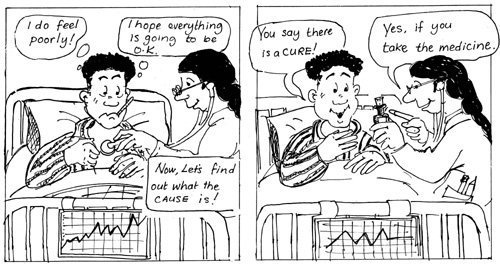 Part of the Enlightenment experience of the Buddha was the direct ‘Knowledge and Vision of Things as they Really Are’; he realised the Truth, or the Dharma.
Part of the Enlightenment experience of the Buddha was the direct ‘Knowledge and Vision of Things as they Really Are’; he realised the Truth, or the Dharma.
He decided that it was possible to help others to realise the Truth for themselves and gain Enlightenment and began to formulate the Dharma, the teaching that leads to Enlightenment. So he put his realisation, which is essentially beyond words, into the conceptual form of the Law of Conditionality.
The Four Noble Truths are an application of the Law of Conditionality to the problem of human suffering. This teaching follows an ancient Indian medical formula:-
illness, cause, cure, remedy.
The Noble Eightfold Path is the fourth Noble Truth – the remedy for human suffering.
The Four Noble Truths Buddhism begins by addressing suffering because no-one can deny the existence of pain. Simply put, the Four Noble Truths are:
- Dukkha – PAIN – physical suffering, psychological pain and existential dissatisfaction.
- Samudaya – The ORIGIN of Pain, which is craving.
- Nirodha – The CESSATION of Pain, which is achieved by overcoming craving. The Third Noble Truth asserts that man can achieve Enlightenment through his own efforts.
- Magga – The WAY to the Cessation of Pain, which is the following of the Noble Eightfold Path.
The Four Noble Truths are a fundamental Buddhist teaching. Despite their concise and simple format, they are a profound teaching that can be understood on deeper and deeper levels.
So, does that mean that cancer is the result of craving? It might be. Lung cancer could be caused by craving for cigarettes, for example. It is also dependent on a number of other conditions: nuclear fallout, genetic predisposition, etc.
However we must distinguish between physical suffering and psychological suffering.
Buddhists who believe in the teaching of rebirth might say (without any sense of blame) that a person’s cancer was partly the result of their being born in a physical body, yet again, as a result of their endless craving for physical existence, when they could have chosen to practise the Dharma more, leading to a rebirth in a different, non-physical state.
Other Buddhists might just say that cancer is one of the many difficult things we may have to face in life, which are hard to explain. What matters is how we respond to it.
One person with cancer may be eaten up with bitterness: “Why me? It’s not fair” etc. This is the kind of suffering which comes with aversion – craving for things to be other than the way they are. This person now has two kinds of suffering. Another person with cancer could choose to see their illness as an opportunity for changing lifestyle, making the most of the time they have left, making sure their friendships are in good repair etc. Because they don’t resist the reality of their situation by craving for things to be different, they suffer less emotional and psychological pain.
Of course, many people with any kind of suffering will experience a mixture of these two attitudes.
Karma

Actions have consequences
Buddhism teaches that all things inevitably change. Because of this it is possible to change things for the better.
We can see evidence of this all around us: a seed changes to become a flower; if we exercise we become fitter; our thinking can improve through study. Buddhism says that we can even do the same with our hearts and minds. By choosing how we act now, we create our future happiness.
The Dhammapada, one of the best-known Buddhist texts, begins with these verses:
Our life is shaped by our mind: we become what we think. Suffering follows an evil thought as the wheels of a cart follow the oxen that draw it.
Our life is shaped by our mind: we become what we think. Joy follows a pure thought like a shadow that never leaves.
Buddhism says that such change is possible because of the Law of Karma.
The word karma means “action”.
The Law of Karma states that actions have consequences: positive actions have positive consequences; negative actions have negative consequences.
Everything we do, think or say has an effect on the world around us and on us. Change will happen to us anyway, but through the choices we make about how to behave, we can change ourselves, and the world around us, for the better.
The Five Precepts
 Behaviour to avoid
Behaviour to avoid
- harming living beings
- taking the not-given
- sexual misconduct
- false speech
- taking intoxicants that cloud the mind
Behaviour to develop
- loving-kindness
- generosity
- stillness and contentment
- truthful speech
- mindfulness, or awareness
They come in pairs, so the first precept is to avoid harming living things and to develop loving-kindness. The precepts are training guidelines which Buddhists follow. They are not commandments to be obeyed. Some Western Buddhists explain how and why they follow the precepts:
1. To abstain from harming living beings
“Some Buddhists are vegetarian. They don’t want to harm animals. The greatest harm you can do to another living being is to kill it. Anything we do to someone without their agreement is an act of violence.
The non-violent path is not a path for cowards.”
2 To abstain from taking the not given
“Pinching money will have a bad effect on me, even if no-one finds out – I’ll know that I’ve acted badly. Making an effort to give whenever I have the idea has a big effect on me, never mind the other person!”
3. To abstain from sexual misconduct
“If I’m in a relationship with someone, then I try to be happy and content with them, rather than looking over my shoulder all the time for someone more interesting. If I’m not in a relationship, I try to be happy and content with that state too. Sex isn’t the most important thing in my life.”
4. To abstain from false speech
“Lying has a bad effect on us. We’re not able to become happier and friendlier if we lie and have secrets. Telling the truth doesn’t always mean saying just what you think.”
5. To abstain from taking intoxicants that cloud the mind
“One of the reasons why I meditate every day is to develop a clear mind. If I was to take alcohol or drugs they’d only make my mind cloudy and dull. It’s not that anyone says to me ‘don’t drink’ – the precepts don’t work like that. I’ve decided for myself.”
STORIES from the BUDDHIST TRADITION: aged 12 and up
These stories, for aged 12 and up, are accessible versions or a ‘re-telling’ of traditional texts from the Pali Canon. They don’t assume any prior knowledge, can be used in any order, and you are welcome to adapt them for your own purposes.
They are offered freely as pdfs, with thanks to Richard Winter from the Cambridge Buddhist Centre.
- Ajatasattu: the value of a life of simplicity, contentment and meditation
- Angulimala: the possibility of transforming one’s life and the difficulties involved in this
- Bahiya: the search for wisdom – beyond words and concepts
- Early Life of the Buddha: the nature of the Buddha’s wisdom
- Elephant and Opinions: why people are convinced that their own wrong opinions are the truth
- Kalamas’ questions: how to distinguish true teachings from the variety of ‘opinions’
- Karma: our good and bad actions always have good and bad consequences
- Kisa Gotami: bereavement, grief and compassion for humanity as a whole
- Meghiya: the importance of friendship in making spiritual progress
- Ocean and Wisdom: the nature of wisdom and the path to wisdom
- Signs ‘Mangala’: the many different aspects of the spiritual life
- Tathagatagarbha (hidden wisdom): each of us already has a hidden Buddha Nature
- Women’s stories 1: are there spiritual differences between women and men? Also the nature of ‘mental control’
- Women’s stories 2: spirituality and beauty, spirituality and physical pleasures
